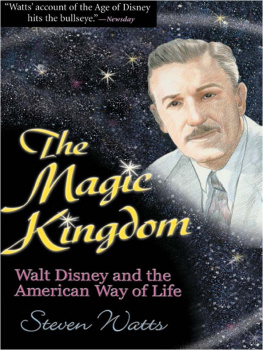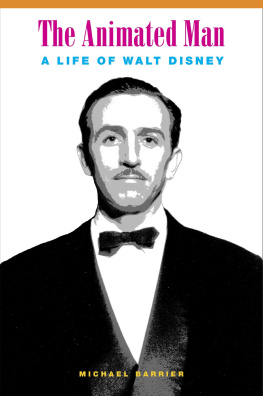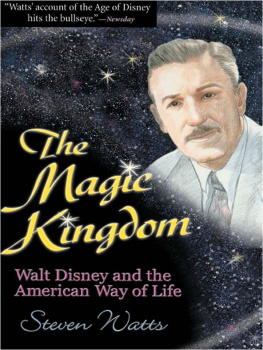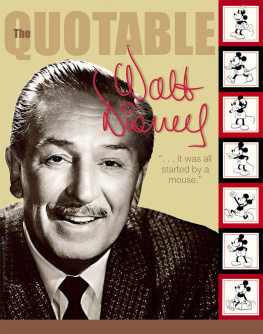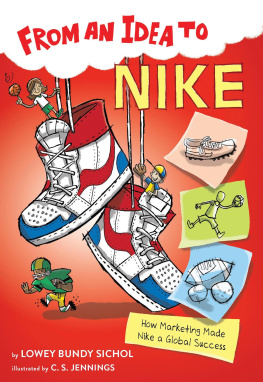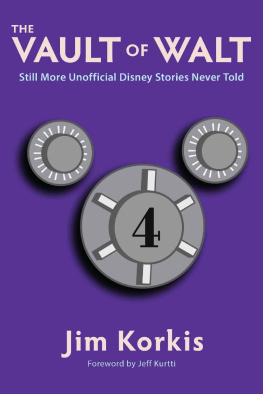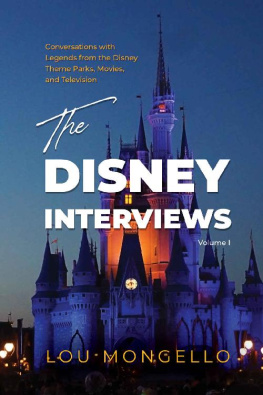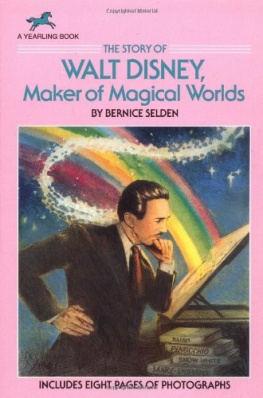Working with Disney
Working with Disney
INTERVIEWS
WITH
ANIMATORS,
PRODUCERS,
AND ARTISTS
DON PERI

www.upress.state.ms.us
The University Press of Mississippi is a member of the
Association of American University Presses.
Copyright 2011 by University Press of Mississippi
All rights reserved
Manufactured in the United States of America
First printing 2011
Library of Congress Cataloging-in-Publication Data
Peri, Don.
Working with Disney : interviews with animators, producers,
and artists / Don Peri.
p. cm.
In this book, as in my earlier book, Working with Walt:
Interviews with Disney Artists, you will meet Disney artists, park
cast members, and on-screen talents Introduction.
Includes index.
ISBN 978-1-60473-939-8 (cloth : alk. paper)ISBN 978-1-60473-940-4
(pbk. : alk. paper)ISBN 978-1-60473-941-1 (ebook)
1. Disney, Walt, 19011966. 2. AnimatorsUnited States
Interviews. I. Peri, Don. Working with Walt. II. Title.
NC1766.U52D52 2010
741.58092273dc22 2010029165
British Library Cataloging-in-Publication Data available

To all the people in this book who shared their stories with me
To my family
And to the families who lived on Chestnut Avenue in San Bruno,
California, between 1953 and 1960, especially the Silver Family
and the Wright Family, who contributed to creating a wondrous
world in which to be a kid and to nurture Disney dreams

Contents
Acknowledgments
I thank all of the people who graciously let me interview them and whose stories are in this book. I have always appreciated how lucky I have been to meet and talk with so many gifted, dedicated people.
Walter Biggins, Anne Stascavage, and the rest of the staff at the University Press of Mississippi were very supportive and encouraging as I undertook my second book for the press. Steve Yates has been very helpful in marketing my books.
Angela Parker helped me tremendously by transcribing the interviews with Sharon Baird and Bobby Burgess. Too young to have watched The Mickey Mouse Club in its initial run, Angela now feels like an honorary Mouseketeer.
Corky Mau assisted me by converting many of my interviews from hard copy, painstakingly typed in precomputer days, to electronic documents.
Vicki Hanson took on the thankless job of proofreading, for which I am very grateful. Of course, I am responsible for any errors that remain.
The State of California provided me with time away from work as a serendipitous result of its staff furlough program.
My wife, Sue; my daughters, Julie and Emily; and my dog, Indi (especially Indi) patiently listened to my unending stories about Walt Disney and his wonderful group of artists. I am grateful that my family has happily let me follow my passion.
As a child of the Baby Boom, I grew up in an America that was experiencing a wave of unprecedented prosperity in the 1950s. My early years were spent in San Bruno, California, where we lived in what I think of as a quintessential Baby Boom neighborhood. Almost all of the families had World War IIveteran fathers and stay-at-home mothers who had moved from nearby San Francisco to the new suburbs near the start of the decade. Chestnut Avenue teemed with children of all ages, so we never had to stray from our block for any kind of kid activities. Because of overcrowding in the schools, we were on a double-session schedule for a couple of years, meaning that we attended school only for half a day. We had plenty of time for sports, games, and, of course, television.
Walt Disney entered our childhood world in a big wayor perhaps I should say on several fronts. At the El Camino movie theater and occasionally at vintage theaters in San Francisco, we watched each new Disney animated feature that was released as well as the rerelease of classic features. (I remember my brother and I cried outside the theater after seeing Old Yeller [1959].) We were also enthralled by Disneys venture into live-action films. In 1954, Walt came right into our homes with his weekly television show. Within months, Davy Crockett coonskin caps sprouted all along Chestnut Avenue. The following year brought not only Disneyland, which we all dreamed of visiting and soon did, but also The Mickey Mouse Club. We all wanted to be Mouseketeers and faithfully wore our ears as we watched the show early each weekday evening. We even formed our own branch of the Mickey Mouse Club (of which, not surprisingly, I was president).
Walt Disney touched our lives, our imaginations, and our hearts; for some of us, that touch has never left. In this book, as in my earlier book, Working with Walt: Interviews with Disney Artists, you will meet Disney artists, park cast members, and on-screen talents who helped Walt achieve his dreams and ours along with him. From the world of Disney animation come top animators Frank Thomas, Ollie Johnston, and Marc Davisthree of Walts famed Nine Old Men of Animation. They animated so many of the memorable characters in the Disney feature films, beginning with the first full-length feature film, Snow White and the Seven Dwarfs (1937). Dave Hand played a huge role at the studio beginning in 1930, and he was the first director (after Walt) of short-subject cartoons. He also directed Snow White. Lance Nolley worked at the Disney Studio as a layout artist, planning the basic composition of each animated scene. Gilles Frenchy de Trmaudan was a 1930s-era animator of many Disney cartoons. From across Hollywood, Walter Lantz was famous not only for his Woody Woodpecker character but also as the host of his own weekly television program, The Woody Woodpecker Show, which began broadcasting just a couple of years after The Mickey Mouse Club. He inherited Walts first popular animated character, Oswald the Lucky Rabbit, and provided a unique perspective to that story and to the animation industry in its Golden Age as a friendly competitor of Walt Disneys. Disneyland would not have been possible without the contributions of many artists, both backstage and onstage at the park. After distinguished careers as animators, Xavier (X) Atencio and Bill Justice joined Walts team of Imagineers at WED (for Walter Elias Disney) Enterprises, now Walt Disney Imagineering. Xavier, or X, as he is better known, has a special place in the hearts of Disney fans because he wrote the lyrics for the Pirates of the Caribbean song that inspired the attraction and the subsequent films. Bill, among other projects, directed The Mickey Mouse Club March on The Mickey Mouse Club and programmed the early audio-animatronics figures at Disneyland. Joyce Belanger, John Catone, and Van France were cast members at Disneyland on opening day in July 1955 and spent more than thirty years helping to create the magic of Walts first theme park. Joyce worked in many areas of the park. John was the spaceman in Tomorrowland as well as a ride operator (in the Disneyland vernacular, an attractions host). Van founded the University of Disneyland and helped train cast members in the Disney way right from the beginning. Lou Debney, a longtime Disney employee, moved from assisting with animated and live-action films into television in its infancy and helped create the unprecedented success of Walts ventures into this new medium. One of the most exciting and innovative efforts in childrens programming,
Next page

